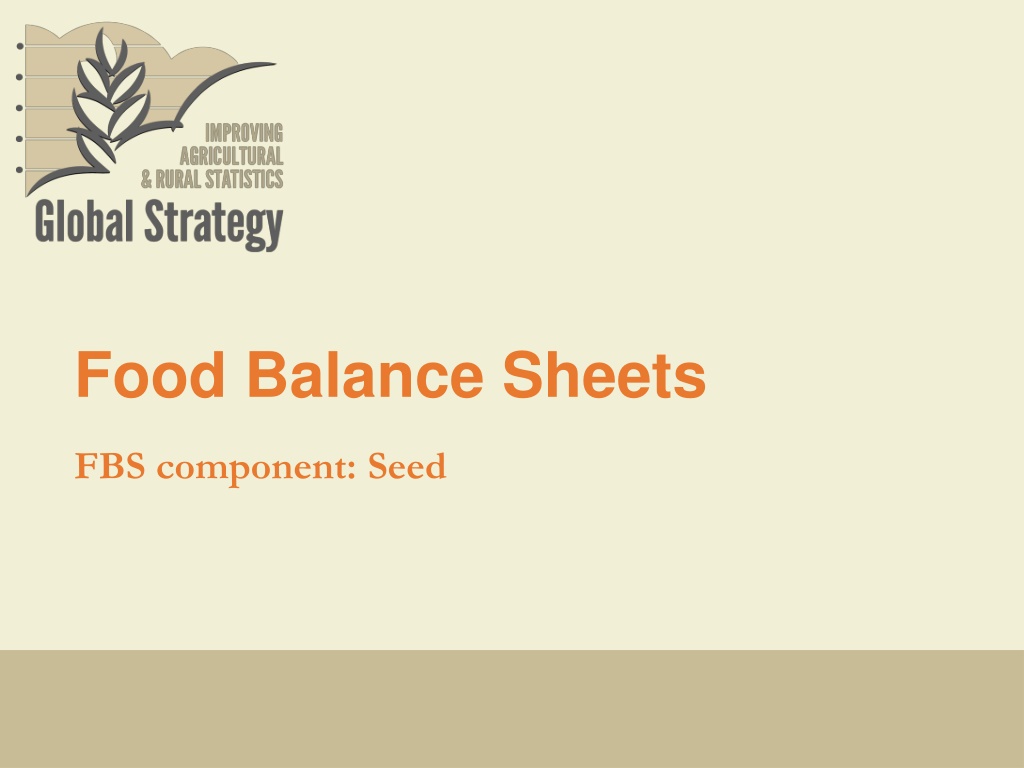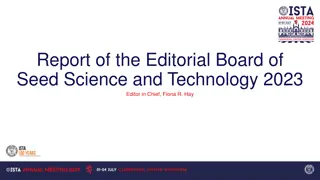Understanding Seed Use Data: Imputation and Estimation Methods
Explore different data sources for seed use, learn recommended approaches for imputation and estimation, understand definitions, and delve into the significance of seeding rates in calculating total seed use quantities.
Download Presentation

Please find below an Image/Link to download the presentation.
The content on the website is provided AS IS for your information and personal use only. It may not be sold, licensed, or shared on other websites without obtaining consent from the author. Download presentation by click this link. If you encounter any issues during the download, it is possible that the publisher has removed the file from their server.
E N D
Presentation Transcript
Food Balance Sheets FBS component: Seed
Learning Objectives At the end of this session, the audience will know: Different data sources for seed. Recommended approach for Imputation and estimation of seed use. 2
Outline Definitions Data sources Imputation and Estimation 3 3
Definitions 4 4
Definition Seed is defined as any quantity of a commodity set aside for reproductive purposes in the following year. This can include seed for sowing, plants for transplanting, eggs for hatching, and fish used as bait. This quantity should also take into account double or successive sowing. 5 5
Data sources 6 6
Data sources Most official measurements of seed use data are sourced from agricultural surveys. Most surveys will include questions on both purchases of improved seed and quantities of own reserved seed, What to do if the survey excludes purchases of improved seed? Possible to access the sales records of commercial seed companies in order to obtain a full estimate of total seed use. Trade data may also give some indications about seed quantities if most seed is imported, as seed typically have separate HS codes. 7 7
Data sources What to do if an estimate of total seed use is not available and a historical seeding rate cannot be calculated from the data? Investigate the possibility of whether or not there is available data regarding only seeding rates. ( technical conversion factor can be a useful source for that) Information on either optimal or effective seeding rates may be available from seed companies or extension specialists, for example. If the typical seed rate is known, then imputing total seed use is a simple calculation, according to the methodology described below 8 8
Imputation and estimation 9 9
Imputation and estimation Seed use quantities in the FBS context represent the amount of seed set aside in the current year that will be used to produce a crop in the following year. As such, seed use in a given year t are a function of : a seeding rate and a sown area in the following year, t+1, ?? ?? ???? ???? ???+? ???? ??? (??)?= ??????? ???? 10 10
Imputation and estimation Given this identity, the process of deriving an imputed value for seed quantity is as follows: Step1: Calculate/estimate a seeding rate. Step2: If missing, impute a value for sown area in the following year. Step3: Multiply the two values together for an estimate of total seed use. 11 11
Imputation and estimation Step 1: Calculate/estimate a seeding rate. If the country has previously planted the commodity in question, then country-level FBS compilers are recommended to just calculate the seeding rate using data from previous years. This can be done by rearranging the previous equation to instead solve for the seeding rate. ???? ??? (??)? ? ???? ???? (??)? ?? ??= ??????? ???? This equation is then utilized on previous time periods for which seed use in one year and sown area in the following year have been reported. 12 12
Imputation and estimation Step 2: Area Imputation If an estimate for sown area in the following year is available, then skip to Step 3 If no estimate for sown area in the following year is available, then sown area must be imputed. This can be done through one of three approaches, depending upon the data available to the country-level compiler. 13 13
Imputation and estimation Step 2: Area Imputation Approach 1: For countries where historical data is available on both sown and harvested area, then the average ratio of sown area to harvested area over the historical series, RatioSH, can be used to impute a quantity estimate for sown area in the following year provided that an estimate of the area harvested in the following year is available 14 14
Imputation and estimation Step 2: Area Imputation Approach 1: Derive RatioSH by calculating ????????, the ratio of each year for which there is a value for both variables, and then average those annual ratios. Sown area Harvested area, in Then that of value RatioSH can be multiplied by harvested area in the following period, t+1, in order to arrive at an estimate for sown area in that same year, as below: ???? ?????+?= ??????? ????????? ?????+? 15 15
Imputation and estimation Step 3: Area Imputation Approach 2: If there is no historical data from which RatioSH can be calculated but data on harvested area is available, sown area can instead be estimated using the harvested area data and an approximation of the amount of area that is sown but not harvested, which is referred to as the abandonment rate. 16 16
FBS component: Seed Imputation and estimation Step 2: Area Imputation Approach 2: First, we can begin by using the identity that harvested area is equal to the sown area multiplied by 1 minus whatever percentage of land is abandoned, abd. ????????? ?????+?= ? ??? ???? ?????+? Rearranged to solve for sown area, the formula becomes: ???? ?????+?=????????? ?????+? (? ???) 17 17
Imputation and estimation Step 2: Area Imputation Approach 3: If it is not possible to calculate a historical ratio of sown to harvested area and an estimate of land abandonment is not possible, but data on harvested area is available: then as a final option, country-level FBS compilers can use harvested area in the following year to approximate sown area in the following year. This approach is equivalent to calculating sown area using either a RatioSH of 1 inApproach 1, or an abd rate of 0 inApproach 2. 18 18
FBS component: Seed Imputation and estimation Step 3: Multiply the two values This approach should only be used when either of the two options above are not possible. Once a seeding rate and sown area in t+1 have been estimated for the product in question, the two values are multiplied to arrive at the quantity of seed needed in year t. 19 19
Imputation and estimation Exercise1 Computation of sown area This table presents hypothetical sown area, harvested area, and RatioSH for sunflowers in CountryA. Compute the mean ration ??????? and give an estimate of Sown area2014 ???????? (C=A/B) Sown area (HA) (A) Harvested area (HA) (B) Year 2010 400 388 2011 425 405 2012 420 395 2013 390 370 2014 ? 385 ??????? = 20 20
Imputation and estimation Correction Year Sown area (HA) (A) Harvested area (HA) (B) 388 ???????? (C=A/B) 2010 400 400/388 = 1.03 2011 425 405 425/405 = 1.05 2012 420 395 420/395 = 1.06 2013 390 404 370 390/370 = 1.05 2014 385 ?.??+?.??+?.??+?.?? ? = 1.05 ??????? = ???? ????????= ??????? ????????? ???????? Sown area2014= 1.05 385 Sown area2014= 404 21 21
Imputation and estimation Exercise2 Computation of sown area Suppose that historical data is not available but Country A harvested 95 hectares of wheat in 2015, and 5 percent of sown area is commonly abandoned before harvest in an average year. calculate an estimated ???? ????2015. correction correction ???? ?????+1=????????? ?????+1 (1 ???) 95 ???? ????2015= (1 0.05) ???? ????2015= 100 22 22
References 3rdChapter of the guideline: Data for FBS compilation: considerations, sources and imputation , 3.5.7 Seed 23 23























